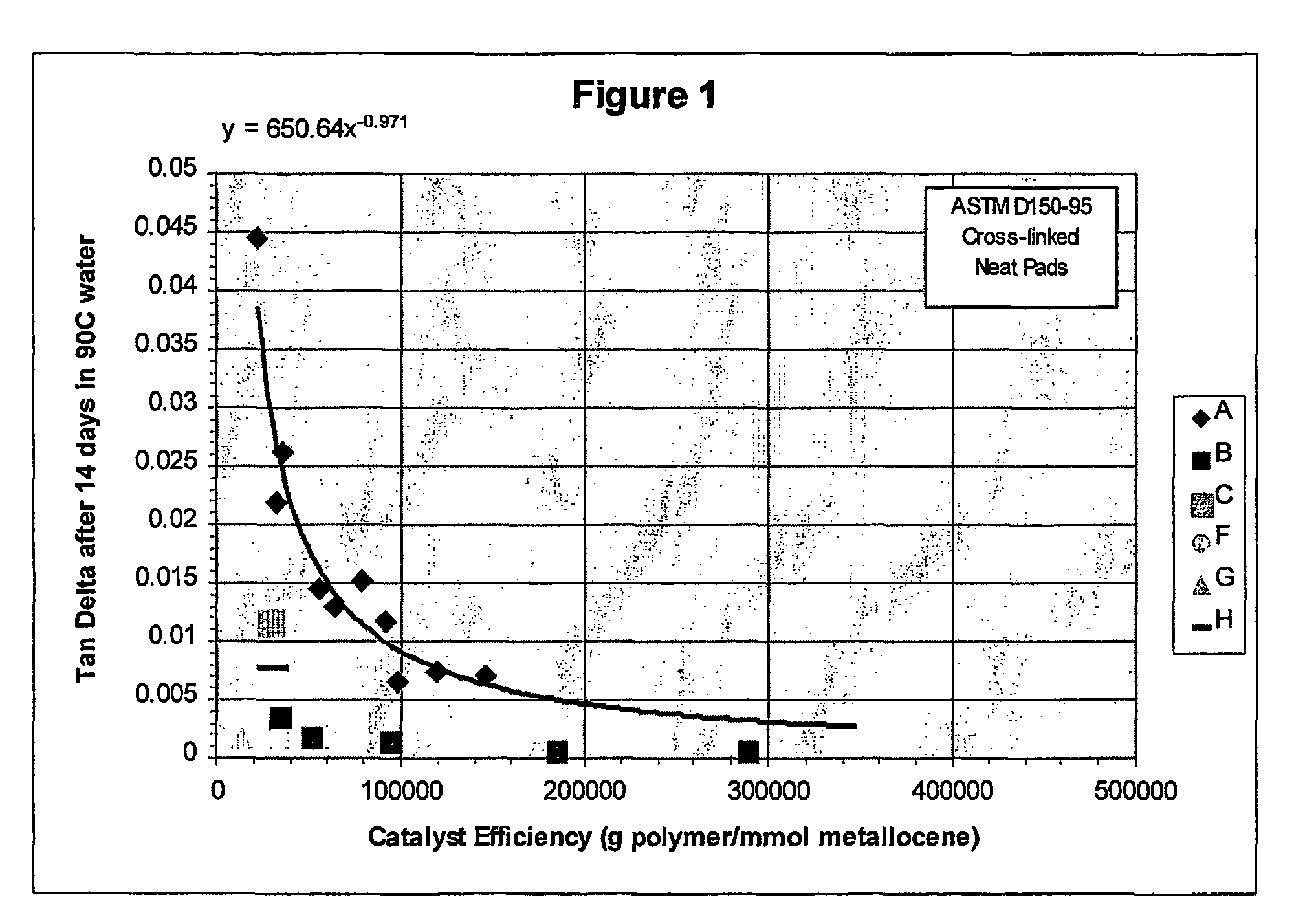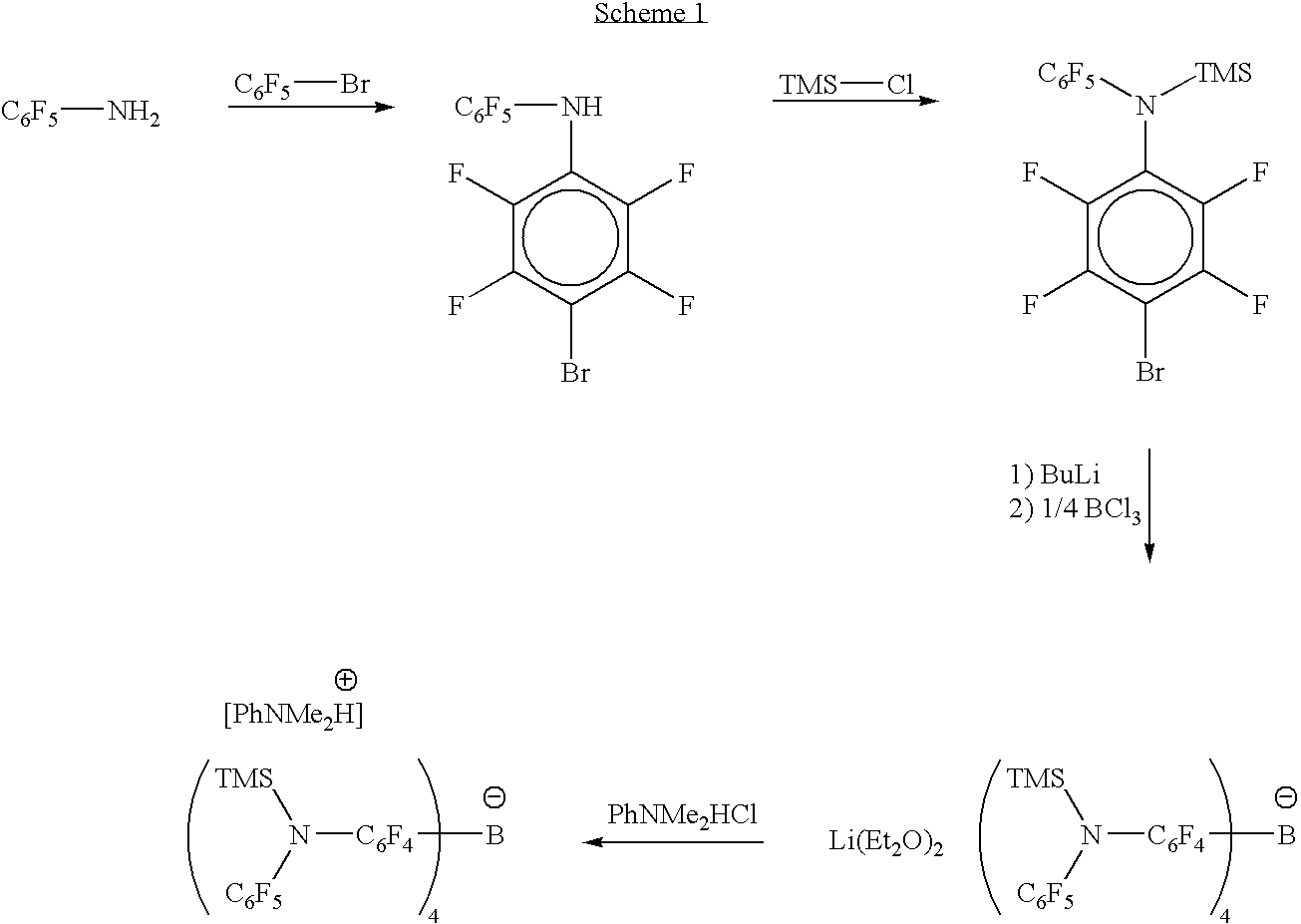Polyolefins made by catalyst comprising a noncoordinating anion and articles comprising them
a technology of olefinic polymers and catalysts, applied in catalyst activation/preparation, synthetic resin layered products, chemical/physical processes, etc., can solve the problems of dielectric loss and reduce their mobility, so as to reduce the mobility, reduce the dielectric loss, and improve the dielectric loss of olefinic polymers made by catalyst systems comprising unsupported ncas
- Summary
- Abstract
- Description
- Claims
- Application Information
AI Technical Summary
Benefits of technology
Problems solved by technology
Method used
Image
Examples
example 1
Synthesis of 4-(C6F5NH)—C6F4Br
[0145]To a suspension of sodium hydroxide (11 grams) in methyl sulfoxide (300 milliliters, DMSO) was added C6F5NH2 (50 grams in 100 milliliters of DMSO). The mixture darkened immediately upon the addition of the amine. To this solution was added C6F5Br (67 grams in 100 milliliters of DMSO). The mixture was stirred for 16 hours. The reaction mixture was added to 300 milliliters of diluted hydrochloric acid (HCl). To the quenched mixture was added 300 milliliters of diethyl ether (Et2O). The two layers were separated. The aqueous layer was extracted a second time with 300 milliliters of diethyl ether. The purple ether layers are combined and dried with magnesium sulfate (MgSO4). After an appropriate drying period the MgSO4 was removed by filtration. The solvent was removed and the product was sublimed (oil bath temperature was 80-90° C., pressure was approximately 10−4 millitorr). The white solid collected on the cold finger was crystallized from hexanes ...
example 2
Synthesis of 4-(C6F5N{TMS})-C6F4Br
[0146]To a potassium hydride (0.610 grams) suspension in tetrahydrofuran (50 milliliters, THF) was added a solution of 4-(C6F5NH)—C6F4Br (6.245 grams in 50 milliliters of THF). After the gas generation stopped, TMS-Cl (1.65 grams) was added. The solution was allowed to stir for 16 hours. The solid precipitate was separated by filtration and the THF was replaced with hexanes. The colorless liquid product was isolated from the yellow mixture by column chromatography (200 mesh silica gel, hexanes). This procedure yields 4.0 grams of product. The product was characterized by 19F NMR. 19F NMR (CDCl3, 25° C., referenced from CFCl3 (0.0)): δ−134.2; (m, 2F), −143.8; (m, 2F), −144.4; (m, 2F), −157.8; (t, 1F), −163.0; (m, 2F).
example 3
Synthesis of [4-(C6F5N{TMS})-C6F4]4B Li(Et2O)2.5
[0147]To a cold Et2O solution of 4-(C6F5N{TMS})-C6F4Br (1.493 grams) was added n-butyllithium (2.0 milliliters, 2.1 M in hexanes, Aldrich). The lithiation mixture was allowed to stir over 2 hours at which point boron trichloride (0.77 milliliters, 1.0 M in hexanes, Aldrich) was added to the mixture. The cold bath was removed and the reaction was stirred for 3 hours. The white precipitate was separated by filtration. The volume of the filtrate was reduced to approximately 30% and pentane was added to induce precipitation. The two-layered mixture was chilled to −35° C. The product precipitates as a white solid (1.135 grams). The product was characterized by 19F and 1H NMR. 1H NMR (Toluened8, 25° C.): δ 3.25; (q, 10H), 1.09; (t, 15H), 0.11; (s, 36H). 19F NMR (Toluened8, 25° C.): δ−133.2; (m, 2F), −145.5; (m, 2F), −150.3; (m, 2F), −160.0; (t, 1F), −164.7; (m, 2F).
PUM
| Property | Measurement | Unit |
|---|---|---|
| voltage | aaaaa | aaaaa |
| voltage | aaaaa | aaaaa |
| voltage | aaaaa | aaaaa |
Abstract
Description
Claims
Application Information
 Login to View More
Login to View More - R&D
- Intellectual Property
- Life Sciences
- Materials
- Tech Scout
- Unparalleled Data Quality
- Higher Quality Content
- 60% Fewer Hallucinations
Browse by: Latest US Patents, China's latest patents, Technical Efficacy Thesaurus, Application Domain, Technology Topic, Popular Technical Reports.
© 2025 PatSnap. All rights reserved.Legal|Privacy policy|Modern Slavery Act Transparency Statement|Sitemap|About US| Contact US: help@patsnap.com



